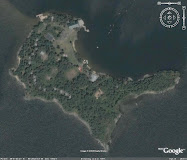By Hal Studholme
A history of YMCA-YWCA Camp Stephens can be told from
many different perspectives: people, structures, changes in programming, even
in the types of boats that served it over the years, But the most profound
history has to be the one that describes TOILETS.
When you have a camp on a
relatively small island, human waste eventually becomes a problem--it’s a
problem for the human race in general, but it becomes a concentrated concern on 24 acres. In the early days with a few adults visiting for a short
three to four month summer season, outdoor “biffies” were more than adequate.
You dig a hole, build a crude hut over it, fashion a seat with a bum-sized
opening, provide an Eaton’s catalogue, and the place is open for “business”!
The only other consideration at the outset is location, preferably downwind
about 50 paces. But as the years go by, two things happen. First you begin
to be concerned about just how many places there are left for another biffy. People,
for some strange reason, get fussy about having one too close to the place
where you live, sleep, eat etc.
Second, as modern conveniences begin to be developed elsewhere, and at home in
particular, you logically want to have the same amenities at camp, or something
that approximates these comforts. A better biffy is the first step. At Camp Stephens,
a communal community exclusively for boys and men, a larger, better appointed,
deeper biffy was created…the “Eight Holer”
This was a definite movement in the right
direction. The facility centralized the function of disposal in a 15 by 20-foot room with a raised, concrete bench along three walls with eight
evenly spaced holes, each with a comfortable toilet seat, paper roles
conveniently placed, vents to provide for the exchange of “airs” and screening
to keep pests to a minimum. Luxury and more. This was a gathering place where friends,
cabin mates, fellow staff could commune and pass the time of day, amongst other
things.
With nearly 200 souls on the 24-acre island at peak camp population, human waste had two other components,
effluent from kitchen operations and the disposal of various other items such
as hundreds of tin cans and bottles which were emptied of their contents over
the camping season, and paper and general food waste.
Over the years these had
been cleverly managed by three efficient but environmentally disastrous
methods. First, kitchen drains: they were simply emptied into a four-inch pipe
which ran directly out onto the lake for about 30 feet where lake currents
swiftly dispersed the effluent. That is except when the wind and lake currents
were flowing towards the front bay, at which times the effluent tended to form
a greasy scum on the sand beaches of, at that time, the beginner swim area.
The
second problem was tin cans and bottles. These were collected in garbage cans
behind the kitchen and twice or more a week the “Chore Boy” would load them
into the small utility boat with the 15-horse power outboard and ferry
them to the vicinity of what was called “bird shit island” a pile of rocks
liberally coated with seagull guano some 300 yards off shore where he
would methodically sink them to the lake bottom some 30 or so feet below.
Decades after the practice had been abandoned, divers from the ‘Y’ scuba club
explored the site and found a mound more than 50 feet in diameter and 20 feet high with many treasures of bygone eras including valuable rare glass and
stoneware bottles. The final problem, other kitchen wastes, was solved by
simply burning them in a concrete fire pit back of the dining hall.
Sometimes
the process had to be assisted with liberal applications of kerosene and white
gasoline. But the system worked well, unless you happened to be down wind at
times such as in the ‘Y’s Men cabin at the start of Junior camp. But they were
eight year olds and didn’t mind, so it was thought.
Back to toilets. Someone eventually got the idea
that a biffy, even one with eight holes and the benefit of collegiality, was
just not the kind of thing the modern camper deserved, coming from a home with
flush toilets, a handy sink, proper lighting and other amenities.
The 7 Come 11
now emerges as the newest system of creative waste management on Copeland
Island. Perched upon the second highest part of the island once dubbed “Pulpit
Rock” (No one remembers why the name) it stood tall and stately for all to see
and was everything one could ask for in a modern public toilet facility, double
sided so that ladies had their own facility with seven toilets and three sinks,
and a men’s side with four toilets, three urinals and two sinks.
It was
perfection, except for one small problem. In order to properly flush a toilet the
system required water pressure that was found in a large municipal water
service, usually about 60 to 80 pounds per square inch.
The camp pump at
the best of times, could only manage 40, and often was struggling to get 30 up to furnish the mechanisms. One flush it could manage, two it might
with great effort, three or more, forget it. The valves in the passageway
between the two sides stayed open, the pump ran continuously, no other toilets
would flush and so remained with contents intact, and the whole process failed miserably.
The solution was a constant process of someone, often the camp director,
turning off the main water supply, and hitting each stuck valve with a hammer
to cause it to close and return the system to “normal” Normal it never was. The
other part of the system that completed the joy was the septic tank and field
that was to “handle” the effluent from the toilets and sinks.
It appears no one
thought to inform camp staff that this element required regular maintenance
which included opening the tank for inspection and if necessary, stirring the
contents to assure proper settling and drainage to the field (which was not
properly constructed in the first place, the seepage from which causing
considerable consternation as it leaked out into the waters at the back of the
island and stained the rocks a rich brown hue).
But what made the whole thing
really ridiculous was the fact that there were only two women on the island on
a regular basis at the time, the camp operating on the monastic model of that
era.(The camp nurse and the wife of the cook used a small, clean, comfortable
outhouse near the hospital) The “Ladies” side of the 7 Come11 was never used,
even in emergencies such as the occasional need for extra facilities when a
bout of diarrhea inflicted a number of the residents at the same time. It was
the “Ladies” washroom and only used on four Sundays of the summer during
visitor’s days or during Girl’s camp in late August, or, if operated, at family
camp. Given the effectiveness of the system, however, it’s probably just as
well!
This “modern convenience” was finally abandoned
in the mid 1970s when it became clear that it was never going to meet the
needs of the camp population and also because it was a definite health hazard.
The “solution” was to revert to biffies again. But what biffies! The new design
was much grander than the old one or two holer. Even grander than the storied
Eight Holer of fame.
The “High Rise” was a small house, divided into two rooms
(camp Leadership having at last realized that there are two sexes on the earth
and girls might like to go to camp too), each furnished with three “straight
drop” toilets, a couple of sinks, and a shower stall on each side. All of these
emptied directly into the rectangular concrete block-walled box upon which the
structure was perched. They were called “High Rises” for this fact, as the base
structure was about six feet high. Three of these “luxuries” graced the camp
and provided relief for the residents as they slowly filled with their noxious contents.
 |
| High Rise #1 |
Oh
yes, the contents. Camp maintenance staff discovered that the only way to
“manage” these services was the draw lots and the ”winner” donned hip waders
and entered the “lower room” in order to spread the piles. It goes without
saying that there was less than enthusiastic acceptance of this role. It also
began to dawn on camp administration that eventually these receptacles would
fill and not only would the High Rises become unusable but the contents would
have to be disposed of somehow, somewhere. Already some ominous brown stains
were developing in the mortar of the lower courses of blocks. There were still
only 24 acres on the island. What to do? Back to the individual, two
hole biffies scattered along the cabin line for an indefinite term while
brilliant minds studied the problem.
The camp board finally tackled the problem seriously
in the early 1980s. A high-tech solution was proposed that seemed to have all
the earmarks of permanence. One of the new board members worked for a firm
which manufactured sewage disposal systems. What he proposed was masterful, a
machine that treated the effluent of a flush system with bacteria! The new system comprised a huge metal
talk about eight feet in diameter and 20 or so feet long.
In the tank were
several great disks which churned the sewage that entered at one end and
exposed it to the action of bacteria to cause it to break down. Effluent would
be filtered and emptied into a large septic field to be constructed near the
tank. The whole “plant” and field would be situated in an ‘unused’ wooded area
below the popular Raspberry Rock. It was promoted as environmentally sound,
economical within reason, and it would preserve the beloved flush toilet system
that city dwellers were fixed upon as necessary for a modern camp. (Larger,
higher capacity pumps would solve the water supply problems of the past system)
Who could ask for anything more? But there was a catch….SLUDGE.
What the promoters of the system failed to
mention in their first glowing description of this marvelous machine was that
at the end of each season somewhere in the neighbourhood of a dozen 45-gallon drums of thick, brown, foul sludge would have to be drained from the
tanks and disposed of. This fact was only discovered when a young, bright member
of the summer camp staff, named Burton Tutt (later Boryen) attended a meeting
and had the temerity to ask a question about sludge production and disposal.
The nerve! He had been reading up on the machine!
After much bluster and
stalling, the fact of the sludge was admitted. But it was quickly dispensed
with by suggesting a barge operator could easily remove the drums and ferry
them to the Kenora sewage plant for disposal. The young man interrupted again
by indicating that the camp had no way of moving the drums to a location on the
island where they could be loaded to a barge, at least not without the expense
of purchasing major equipment to carry out the task. He then made the most
damning disclosure as far as the machine’s promoters were concerned; not only
was there no operator on the lake who would do the barging of the barrels he
pointed out that Kenora sewage plant had no capacity to accept such gifts as
the Camp Stephens annual sludge production. The dream of our own sewage
treatment plant was gone.
But the enterprising Mr. Tutt was not finished.
He proceeded to make a masterful presentation complete with drawings, photos,
cost estimated and time lines for a system he had researched a year previously
on a trip to Sweden. The Clivus Multrim system featured large tanks which composted human and kitchen
waste, producing rich compost after a year or two that could be used for the
camp tree nursery. The plan included a small treatment system for kitchen grey water
effluent that had been developed by a professor at University of Manitoba and successfully installed in several locations in
the province.
 |
| Don Cochrane assembling a Clivus |
 |
| Clivus #1 |
To the everlasting credit of the board, they saw the wisdom of this
alternate, environmentally sound plan. To top it off, a grant appeared to be
assured from the federal government for the bulk of the cost of the project. The board and threw their whole support into the venture.
The development and
installation of the two systems, however, were not without problems. One of the
most formidable came from the Northwest Ontario Health Department, or rather,
the chief inspector. In his wisdom, he refused to believe that a composting
process worked, and certainly not on the scale envisioned by Camp Stephens.
Moreover, he had given his approval for the previous (and proven flawed)
treatment plant.
His obstructions nearly stopped the process for good many
times. Ultimately it went ahead and still functioned satisfactorily more than 20 years later. The health inspector?
Well, he made annual visits every fall until his retirement searching
for the contents of the Clivus tanks in the firm belief that we buried same
contents somewhere on the island and composting didn’t work and never would!
Epilogue….in the end (2007) The Clivus
maintenance process, which required systematic attention, turned out to be
beyond the abilities of camp staff as the years went by and fell into disarray, the
tanks filled and the old inspector won his point at last. The Clivus’s were dismantled,
their contents buried (as with other past waste collections) and Camp went back
to a flush system.
Here we go again! Story to be continued.












